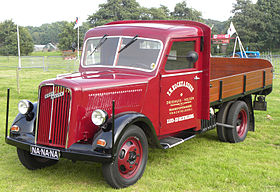Opel Blitz
| Opel Blitz | |
|---|---|

Blitz 1.5 T
|
|
| Overview | |
| Manufacturer | Opel (General Motors) |
| Production | 1930–1975 |
| Assembly |
Rüsselsheim Opelwerk Brandenburg, Mercedes-Benz Mannheim Blitz 3.6 until 1944 |
| Body and chassis | |
| Class | light/medium truck/ light commercial vehicle |
| Body style |
Van Pickup truck Minibus |
| Chronology | |
| Successor | Bedford Blitz |
Opel Blitz (German for "lightning") was the name given to various light and middle-weight truck series built by the German Opel automobile manufacturer between 1930 and 1975. The original logo for this truck, two stripes arranged loosely like a lightning symbol in the form of a horizontally stretched letter "Z", still appears in the current Opel logo.
During the years preceding World War II Opel, a subsidiary of General Motors (GM) since 1929, was Germany's largest truck producer. The Blitz name, found in a prize competition, was first applied to an Opel truck in 1930.
By 1934 there were four base versions offered of the 1 tonne basic model along with fourteen versions of the larger 2 and 2½ tonne trucks. Under the terms of Nazi economy and the German re-armament the authorities ordered the construction of the Opelwerk Brandenburg facilities in 1935, where until 1944 more than 130,000 Blitz trucks and chassis were produced. The medium-weight versions originally were equipped with a flathead 68 HP petrol engine coming from the 1930 GM Buick Marquette, replaced in 1937 with a modern overhead valve 75 HP straight-six engine also used in Opel Admiral passenger cars. This engine was very similar to Chevrolet engines from the same period, to the point that disabled Blitzes abandoned by fleeing Germans could be easily put back into operation by advancing Allies using Chevy/GMC and Bedford parts.
From 1939, the reliable Blitz 3.6 three-ton version was used in large numbers by the German Wehrmacht armed forces throughout World War II. Derived variants included an elongated version and the four-wheel drive Blitz A. To cope with the bad road conditions and the rasputitsa mud seasons on the Eastern Front, a half-tracked Maultier (mule) SdKfz 3 version was built using tracks and suspension based on the Universal Carrier. Among others, these were used as service vehicles for the Messerschmitt Me 323 military transport aircraft. It is also claimed that Opel, a subsidiary of GM, used forced labor to reap unprecedented profits. To what degree GM controlled Opel at the time is subject to debate, but it is clear that GM did in fact play a role in giving Nazi Germany the Opel Blitz truck.
...
Wikipedia
